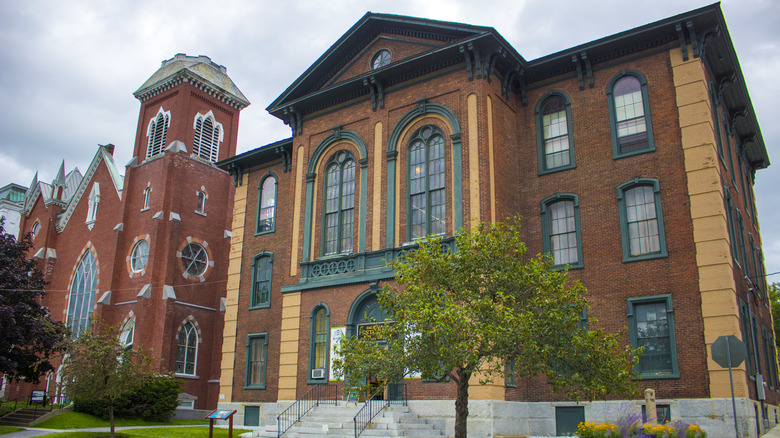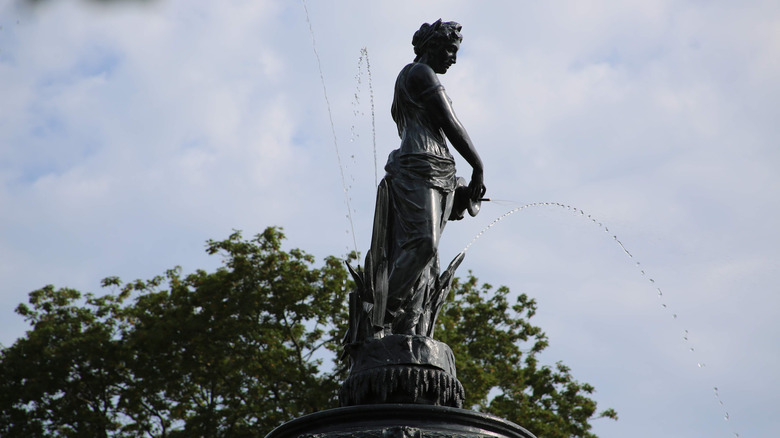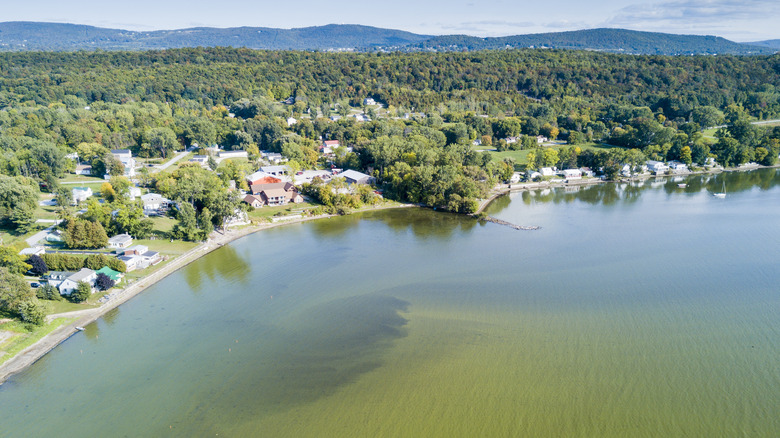Vermont's Underrated Lakeside Town Surprises With Victorian Streets, Craft Brews, And Cute Shops
One surprising success story in Vermont is Saint Albans. This tiny lakeside city of 7,000 people, 30 miles north of Burlington, is witnessing a revival of sorts after decades of economic depression. More and more businesses and residents are moving in, and it's easy to see the appeal. The downtown is filled with handsome 19th-century buildings hosting charming mom-and-pops, cafes, and eateries alongside Taylor Park — Vermont's first. Lake Champlain is just a few miles away, offering every manner of water sport, not to mention the picturesque Vermont islands just offshore for outdoor lovers. In every other direction, the green forests and mountains that give Vermont its name stretch toward the horizon.
Start any visit to St. Albans in Taylor Park, the hub of the downtown district at the junction of Main and Lake Streets. The three-level aluminum fountain, decorated with maidens, cherubs, and a water nymph, is a particular point of pride for the city. From there, you can spend several hours shopping at places like Rail City Market, Artist in Residence Gallery, and Moonshadows Gifts for the Spirit, in between coffee breaks at Catalyst Coffee Bar and bites at The Drake Bar and Kitchen, Twiggs American Gastropub, and Jeff's Maine Seafood. Arrive on a Saturday between May and October, and you can also browse the Northwest Farmers Market. To the craft beer tapestry of Vermont, St. Albans contributes 14th Star Brewing and Mill River Brewing BBQ and Smokehouse — both open to visitors.
History and recreation in Saint Albans
For history fans, Saint Albans bears the distinction of being the site of the northernmost "battle" of the Civil War. On October 19, 1864, Confederate raiders crossed from Canada and robbed banks, shot citizens, and attempted to burn down the town — one of many stories told at the St. Albans Museum downtown. There, you can also learn about the Abenaki Natives who called the area home for 3,000 years, the railroad that shaped St. Albans, and the agriculture that has sustained its farmers since its founding in 1763. Get up close and personal with the latter on a visit to nearby farms like Blue Moon Farm and Hudak Farm.
In St. Albans itself, Hard'ack Recreation Area hosts sports and activities year-round, including disc golf, hiking, and mountain biking in the warmer months and skiing, sledding, and snowshoeing in the winter. A few blocks north of that, you can find one end of the Missisquoi Valley Rail Trail, which runs 26.4 miles through a pastoral New England landscape. America's longest paddle trail, the Northern Forest Canoe Trail, also passes just to the north of St. Albans. In winter, serious skiers head 40 miles east to one of Vermont's largest ski resorts, Jay Peak. But it's Lake Champlain that remains the heart of nature activity, whether it's strolling along the banks at St. Albans Bay Park, dipping into the waters at Cohen Park, picnicking at Kill Kare State Park, or cruising the waves on rented boats and jet skis.
Getting to and around Saint Albans
As remote as Saint Albans is, it's remarkably well-served by transportation links. Two international airports operate within 75 miles of it — Patrick Leahy Burlington International Airport, a half-hour's drive south, and Montréal–Pierre Elliott Trudeau International Airport, just over an hour and a half north. St. Albans is also the northern terminus of Amtrak's Vermonter line, which runs south to Washington, D.C. in about 13 hours. If you're coming from New York, you can also approach St. Albans by ferry, crossing Lake Champlain from Plattsburgh, disembarking on Grand Isle, and driving the remaining 30 miles. Greyhound operates a Boston–St. Albans bus route and Green Mountain Transit runs between Burlington and St. Albans on weekdays. Thanks to Interstate 89 passing nearby, driving is easy too — and necessary for exploring anywhere beyond the downtown area.
Due to St. Albans' size, hotel options are relatively limited, with a Hampton Inn and Holiday Inn Express downtown. Otherwise, Airbnb is the best local option. A bit further afield, you'll find quaint inns such as Back Inn Time, the Yellow Farmhouse Bed and Breakfast, and the Inn at Buck Hollow Farm. Anything more boutique or upscale means heading south to Burlington. The same goes for digital connectivity — cell phone signals in Vermont tend to drop bars, sometimes all of them, the more rural you go. Campgrounds are plentiful throughout the region, especially along the lakeshore and nearby islands.


